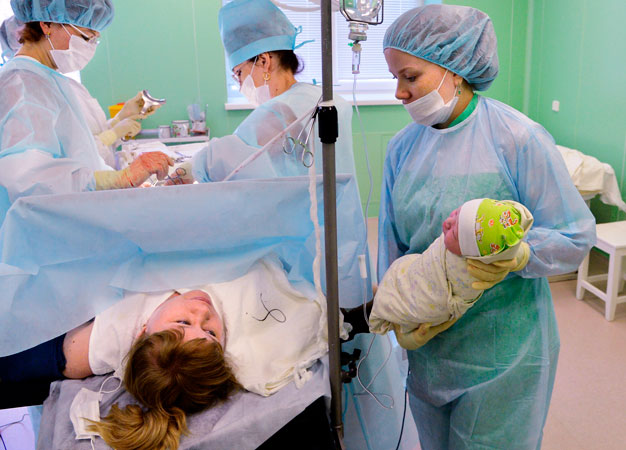A protein in the placental lining helps synthesize a fetal hormone that signals to pregnant mothers to begin contractions
Published online 22 March 2018

A possible biological explanation for the increase in births by cesarean sections has been found by Keio researchers.
© SPUTNIK/SCIENCE PHOTO LIBRARY
Rates of childbirth by cesarean section are on the rise worldwide, and while there are some social reasons for this increase, an all-Keio team of researchers has identified a potential biological one1. Specifically, Masatoshi Tomi at Keio University's Faculty of Pharmacy and his colleagues found that a transporter protein called OAT4 is needed for the fetus to signal to its mother to begin contractions. When this protein is faulty, labor gets delayed, which may partially account for the high incidence of cesarean sections in Japan and elsewhere.
OAT4 is expressed in the placenta and kidney. It helps the developing fetus both to get rid of toxins and to synthesize various sex hormones, including estradiol, estrone, and estriol (collectively known as estrogens). The impact of OAT4 on estradiol and estrone signaling is better known than its effect on estriol signaling, despite estriol being the only estrogen that arises solely from a fetal-derived precursor.
To test the role of OAT4 in conveying the estriol precursor from the fetus across the placenta, Tomi and his team studied a population of placental cells called syncytiotrophoblasts, which cover finger-like projections from the placenta that invade the wall of the uterus and enable nutrients to circulate between the fetus and the mother.
In particular, the researchers looked at the part of the syncytiotrophoblast cell membrane that faces the fetal side. They created tiny capsules from this membrane and found huge numbers of OAT4 proteins, which proved to be essential for the passage of the estriol precursor.
According to Tomi, most studies on estrogen synthesis processes have focused on the action of enzymes. "In contrast, our study has highlighted the importance of membrane transporters," he says. "Our finding will be a trigger to put more emphasis on the transporter in estrogen synthesis by the fetoplacental unit."
Recent studies from Tomi and his colleagues have found that OAT4 proteins in the same syncytiotrophoblast cells help the fetus transport an antihistamine drug called levocetirizine and a blood pressure drug called olmesartan. Notably, OAT4 is found only in primate cells; it does not occur in rodents. That could help to explain a uniquely human side effect of anti-hypertensive drugs such as olmesartan. In mouse models, agents from this drug class caused no problems to developing pups, but there is a high risk of life-threatening kidney damage in the fetuses of human mothers who take the medicines. "It is plausible that this fetal toxicity is facilitated by the presence of OAT4-mediated transport," says Tomi.
About the researcher
Masatoshi Tomi― Professor
Faculty of Pharmacy, Keio University
Masatoshi Tomi was born in Ishikawa, Japan, in 1975 and received his PhD in 2003 from Tohoku University. He started working at Keio University in 2009 and was appointed a professor in 2016. His research focuses on membrane transporters at the placental barrier and the physiology/molecular biology of the barrier function.
Links
Reference
- Tomi, M., Eguchi, H., Ozaki, M., Tawara, T., Nishimura, S. et al. Role of OAT4 in uptake of estriol precursor 16α-hydroxydehydroepiandrosterone sulfate into human placental syncytiotrophoblasts from fetus. Endocrinology 156, 2704-2712 (2015). | article
